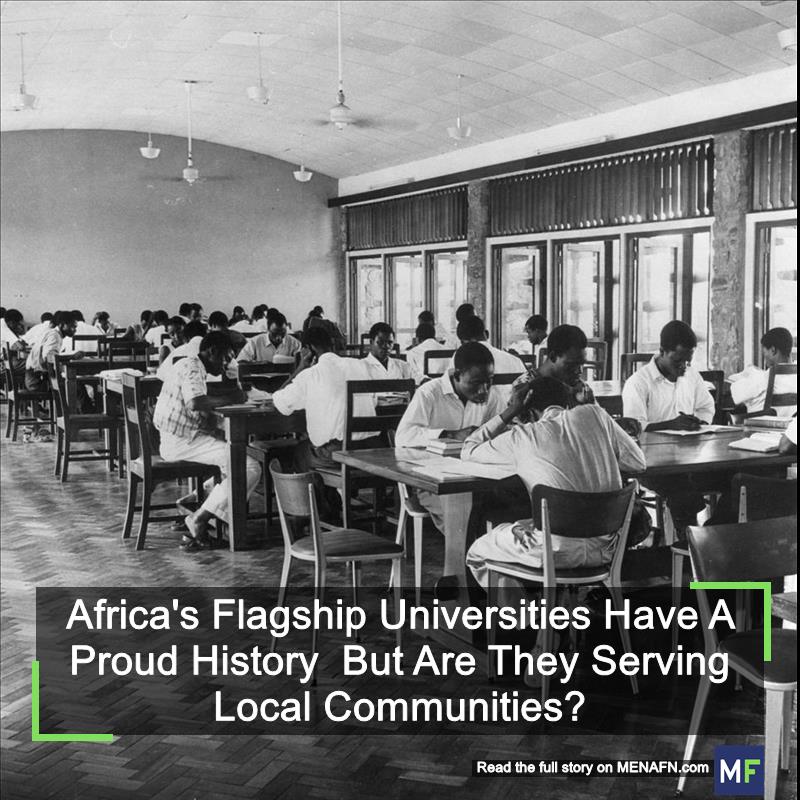DON'T MISS ANYTHING!
Subscribe to our newsletter
Lorem ipsum dolor sit amet, consectetur adipiscing elit.
Listeners:
Top listeners:
LISTEN NOW: JafriQ Radio Live On Jafriq Radio

[ad_1]
Universities play a number of crucial roles in society. They educate students, research solutions to problems and serve as spaces for national debate. This is especially true for large public institutions, often referred to as flagship universities. A number were launched with great fanfare around the time of a country’s independence from colonial rule. They were tasked with driving national development by training skilled graduates to fill workforce gaps and conducting applied research to address societal challenges. Many have done well in their historic national missions. But how are they performing today when it comes to serving their local communities?
Higher education researcher James Ransom set out to answer this question in his new book, Revisiting Africa’s Flagship Universities: Local, National and International Dynamics. He analysed local engagement at ten African flagship universities: Ethiopia’s University of Addis Ababa; Makerere University in Uganda; the universities of Ghana, Namibia, Rwanda, Mauritius, Zambia and Zimbabwe; the University of Cape Town in South Africa and Nigeria’s University of Ibadan. He tells The Conversation Africa what he learned.
What is a flagship university?
They are pillars of the nation: their campuses are intertwined with history as sites of protest and revolution; their researchers lead the way in publications and research; their students are tomorrow’s leaders.
Sometimes there is one flagship in a country. Sometimes a country will be home to several. In Nigeria, the University of Ibadan is joined by the University of Nigeria at Nsukka.
Small, specialist institutions and private universities all play important roles in national higher education systems. But flagships are the trendsetters. They often mentor new universities by seconding senior staff to lead them, and helping design the curricula. Their staff sit on government committees. They have international partnerships and projects.
The term “flagship” has been used elsewhere in the world, not just in post-colonial countries. In the book I focused on Anglophone sub-Saharan Africa, including countries that were not traditional colonial states, such as Ethiopia.
Read more: The untold story of how Africa’s flagship universities have advanced
What made you write this book and why now?
In the UK, where I live, we have seen a shift in the expectations placed upon universities.
The “redbrick” universities, such as Birmingham and Liverpool, are a good example. They were founded in the 19th century to meet local needs. Then they developed strong global ambitions over the next hundred years, excelling in world-leading research and innovation.
During the past couple of decades, the local question returned: what are you doing to serve your local community? The redbricks (and many others) have responded – nudged along by national policies and frameworks – with serious programmes of civic engagement. These include projects designed with communities, seconding staff into local planning organisations, and opening up their campuses to communities – from 5-a-side football pitches to photography exhibitions.
The shift I witnessed in the UK, and mirrored in my work across Europe and Canada, made me wonder: has a similar shift, from a historic national mission to a local one, taken place for African universities?
The question is timely. Societal challenges may be national or global in scale. But they need local knowledge and local partnerships to solve at the local level. This means universities working with local government, which is a key focus of my work. The Organisation for Economic Co-operation and Development has calculated that 100 of the 169 UN Sustainable Development Goal targets can only be achieved if local governments are involved. Universities can play an important supporting role.
What did you find?
It is clear that flagship universities’ local work is growing and will continue to grow. For instance, Addis Ababa University established a railway engineering centre to train engineers to maintain the city’s light rail transit system, with students employed by the Ethiopian Railway Corporation. The University of Ghana runs satellite campuses in all ten regional capitals. This allows it to reach remote areas and to establish a local presence in different regions.
Successful projects often emerge from deep links with local communities. Ibadan has worked closely with a few communities over many decades. These “field laboratories” include a community health programme in the village of Ibarapa, which began in the early 1960s with funding from the Rockefeller Foundation and technical support from the Liverpool School of Tropical Medicine and the London School of Hygiene and Tropical Medicine.
The programme has trained hundreds of medical students in community medicine through practical work in rural areas, while also improving health services and conducting research on health issues in the Ibarapa community. An example is studying and addressing neglected tropical diseases such as onchocerciasis (river blindness) and guinea worm.
In 2020 the University of Ibadan signed a memorandum of understanding with the local government on the Ibarapa programme. Over half a century after it began, local partnerships continue to sustain the programme.
However, a national focus continues to dominate at all ten institutions I studied. This is perhaps best illustrated by the University of Rwanda. Local engagement activity is secondary to the nation’s development strategy spearheaded by its Vision 2050, an ambitious effort to become an upper-middle income country in the next 25 years.
There is some local activity, of course. Students provide health services to the community, staff run community workshops on informal housing, and there are plans to open model farms to showcase irrigation and agricultural mechanisation. But all of this ultimately serves the national vision.

Get the latest in African news delivered straight to your inbox
Almost finished…
We need to confirm your email address.
To complete the process, please follow the instructions in the email we just sent you.
There was a problem processing your submission. Please try again later.
Rwanda is a small country, but this finding – of national priorities dominating at the expense of local programmes – was consistent across all the flagships I studied, in large countries like Nigeria as well as in other small countries like Mauritius and Namibia.
What can other universities on the continent learn from your findings?
Flagships are complex institutions, with rich histories and often complicated relationships with government. They are survivors, skilled at balancing multiple roles. There is much that other universities can learn from flagships, and that flagships can learn from each other – and more of these partnerships are needed.
But one senior staff member at a flagship university told me that many African university heads
feel rather oppressed by the narratives from higher education leaders in other parts of the world
They were talking about international benchmarking, unequal research partnerships, and models of “best practice”. These constrain the local role of flagships, creating identikit institutions. The result is a race to local irrelevance. Relevance can only emerge from an approach that reflects the local and national context.
Universities that capture the work they do locally, effectively communicate this, and can demonstrate how it is relevant to society, will be in a good place to chart their own path as a pillar of the nation.
James Ransom, Researcher: societal challenges, UCL
[ad_2]
Written by: jafriqradio
africa Business current events economy Education news Politics sports trade travel

For every Show page the timetable is auomatically generated from the schedule, and you can set automatic carousels of Podcasts, Articles and Charts by simply choosing a category. Curabitur id lacus felis. Sed justo mauris, auctor eget tellus nec, pellentesque varius mauris. Sed eu congue nulla, et tincidunt justo. Aliquam semper faucibus odio id varius. Suspendisse varius laoreet sodales.
closeLorem ipsum dolor sit amet, consectetur adipiscing elit.
© JAfriq RAdio 2024 All Rights Reserved. By Octagram, Inc
Post comments (0)